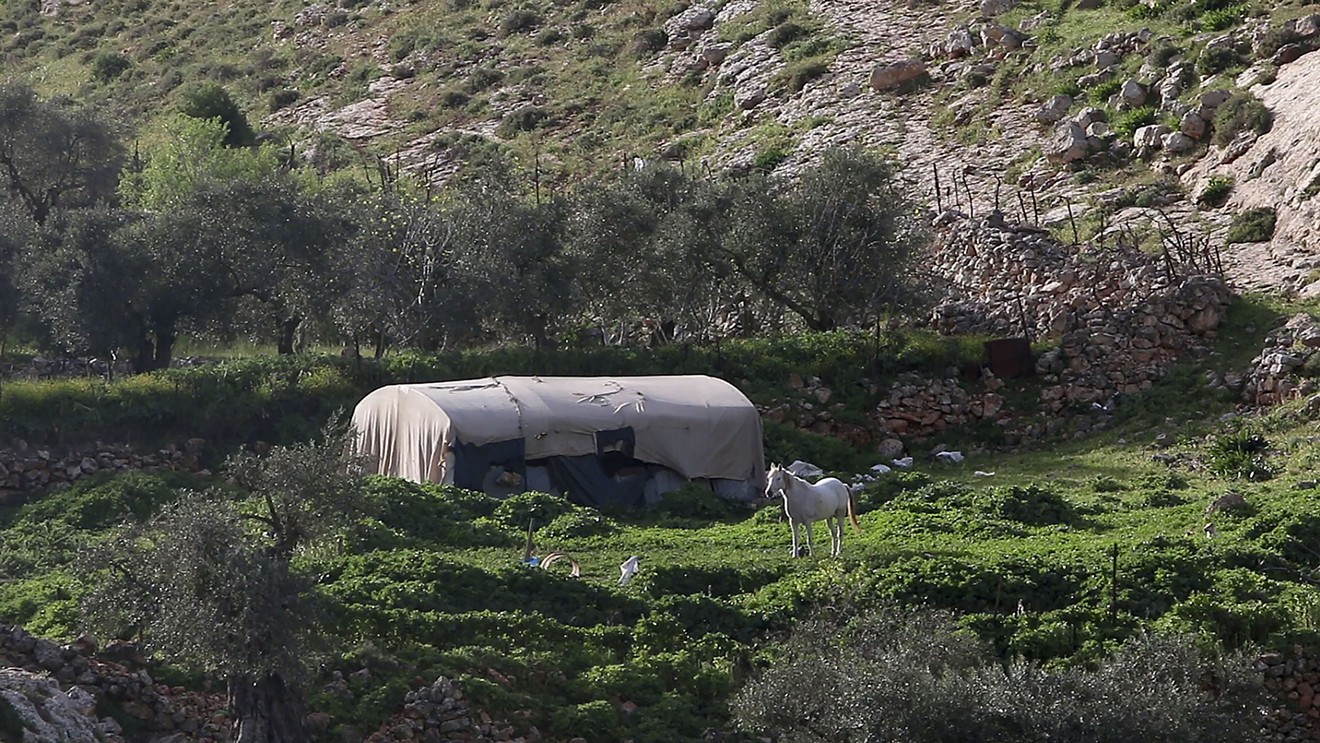When you think of land in Palestine, conflict might be the first thing that comes to mind. But for Jumana Emil Abboud, the Palestinian landscape evokes other, older associations — with mythological creatures such as water spirits and ghouls.
“These stories were told way before 1948,” the Galilee-born artist says by phone from her home in Jerusalem. She suggests looking back centuries before the declaration of the Israeli state and the current tensions in the region. “Our connection to the landscape and the water sources was very deep and beautiful.”
Emil Abboud grew accustomed to imagining her homeland after her family moved to Canada when she was 8 years old. “We tried to maintain a Palestinian culture in our home,” she recalls. That included telling folk tales about the villages the family left behind.
When she returned to Israel to study art in her early 20s, she began looking for the places she had heard about in those tales. Unlike the forest Hansel and Gretel navigated or the bridge the three billy goats gruff crossed in Western folktales, the stories Emil Abboud had grown up hearing could be plotted on a map, near a “specific tree, spring, or well.”
“For my aunts and my grandmothers, these were not just words,” she says. “People believed a specific water source connected to a story could cure, or it was haunted, so we were told [not to] go there or we would find a ghoul.”
Adding to the tales she heard from family members, Emil Abboud pored over books such as Speak Bird, Speak Again: Palestinian Arab Folktales, collected by Ibrahim Muhawi and Sharif Kanaana, and a 1922 tome by Dr. Tawfiq Canaan, a Palestinian physician-turned-ethnographer, who happened upon the tales. Emil Abboud recounts, “Many of his patients would pay him by giving him talismans and ritual stories.”
The artist and her collaborator — photographer and videographer Issa Freij — set out to find the “haunted sites” mentioned in these tales in “ancient water sources” and “old caves.” They discovered about 20 sites they believe to be connected to specific folktales. These sites are revealed in Maskouneh (Inhabited), a nonnarrative, three-channel video that lingers on landscapes nearly devoid of human presence. Birdsong echoes through forests, a horse wanders a rocky field, a series of hills partly blots out a distant city. Pink flowering trees bloom. A goat bleats. Rain falls, streams burble, water drips in caves. Here and there, a human figure sits, small in the distance.
Conspicuously absent are the military checkpoints and the wall that separates Palestinian territory from Israel. Emil Abboud confirms she purposely omitted those barriers. "I wanted to give the sense that this landscape embraces you openly, unconditionally, and freely."
Emil Abboud and Freij will welcome Miami audiences into that landscape when they screen Maskouneh as part of the performance series Living Together, hosted by the Museum of Art + Design at Miami Dade College. The video will be one part of Out of the Shadows, a performance that has been evolving for more than seven years.
In the first part of the performance, Emil Abboud the storyteller will recount Palestinian folktales as her elders once did. A video of her recounting stories in an earlier version of Out of the Shadows last October, at the Darat al Funan gallery in Amman, Jordan, shows her speaking in an understated style, her eyes filled with quiet wonder.
In the second part, she promises to weave the Palestinian tales with those more familiar to her audience. During this interview, she reported that she was taking a break from “doing her homework” on South Florida folktales. During the performance, she will solicit tales directly from the audience.
For the third part of the performance, against the backdrop of Maskouneh, she and Freiji will tell contemporary stories of how they found the sites shown in the video. Again, Emil Abboud insists, they will shy away from any overtly political encounters and instead comment on their experience of the natural and the supernatural.
The supernatural also appears in Emil Abboud’s drawings of the water spirits and monsters that haunt the folktales. Despite their fearful content, these drawings are delicate and whimsical: A pale-green bird with a woman’s face stands with wings raised; a fish with a pastel patchwork of skin reveals sharp teeth.
“For me, a monster is an idea, not a physical being,” Emil Abboud says. “I tried to make the drawings all look the same, so the ghoul looks like the beautiful bride. You can’t tell which is the monster and which isn’t the monster.”
— Celeste Landeros, Artburstmiami.com
Out of the Shadows, by Jumana Emil Abboud and Issa Freij. 7:30 p.m. Friday, February 23, at Miami Dade College Wolfson Auditorium, 300 NE Second Ave., Miami; mdcmoad.org. Admission is free with RSVP via brownpapertickets.com.
[
{
"name": "Air - MediumRectangle - Inline Content - Mobile Display Size",
"component": "19274298",
"insertPoint": "2",
"requiredCountToDisplay": "2"
},{
"name": "Editor Picks",
"component": "17482312",
"insertPoint": "4",
"requiredCountToDisplay": "1"
},{
"name": "Inline Links",
"component": "18711090",
"insertPoint": "8th",
"startingPoint": 8,
"requiredCountToDisplay": "7",
"maxInsertions": 25
},{
"name": "Air - MediumRectangle - Combo - Inline Content",
"component": "17482310",
"insertPoint": "8th",
"startingPoint": 8,
"requiredCountToDisplay": "7",
"maxInsertions": 25
},{
"name": "Inline Links",
"component": "18711090",
"insertPoint": "8th",
"startingPoint": 12,
"requiredCountToDisplay": "11",
"maxInsertions": 25
},{
"name": "Air - Leaderboard Tower - Combo - Inline Content",
"component": "17482313",
"insertPoint": "8th",
"startingPoint": 12,
"requiredCountToDisplay": "11",
"maxInsertions": 25
}
]












